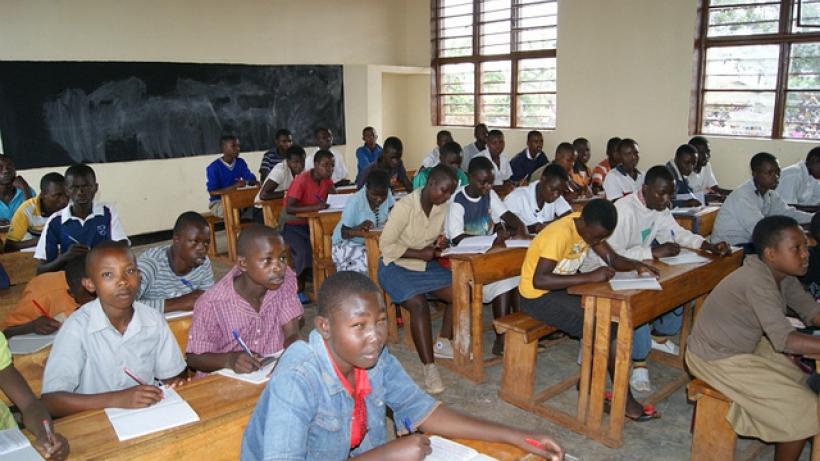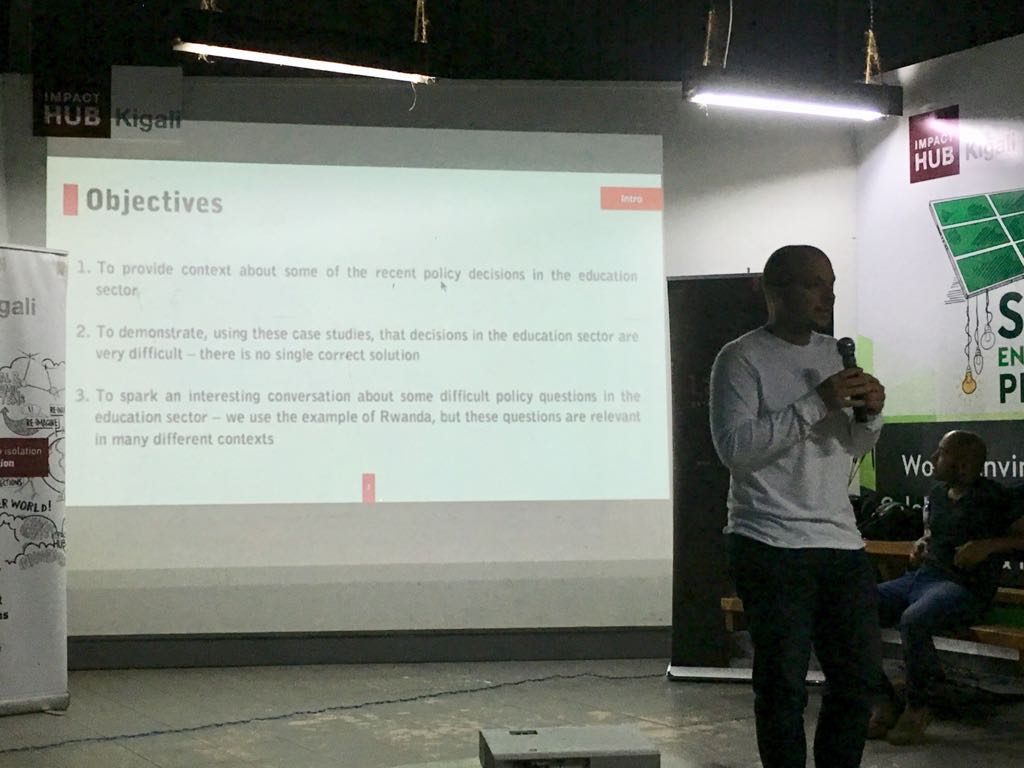
Challenges and choices in the Rwandan education system: R3 roundtable discussion
Education is a vital part of any economic growth strategy. However, implementation in Rwanda must overcome a number of challenges including dropout rates, nutrition, teaching hours, teacher recruitment and management, and the need to develop a reading culture. In this blog post, Jonathan Bower describes presentations by researchers from Laterite and from Georgetown (IGC-funded), and from a teacher who passionately promotes reading culture, at an R3 Roundtable Event held in Kigali in June 2018.
The Government of Rwanda’s Education Sector Strategic Plan for 2018/2019 – 2023/24 (ESSP) gives a blueprint for an education system that seeks to “ensure Rwandan citizens have sufficient and appropriate skills, competences, knowledge and attitudes to drive the continued social and economic transformation of the country and to be competitive in the global market”. However, a number of major challenges must be overcome in order to achieve this impact. On 19 June 2018, the IGC jointly hosted an event with Laterite[1] and Innovations for Poverty Action, at which three researchers and an experienced teacher engaged with the challenges and choices faced by Rwanda’s education system with respect to basic education, literacy, and reading culture.
Four difficult policy choices
Dimitri Stoelinga and Sachin Gathani, founders of research firm Laterite, described four challenges and their associated difficult policy choices.
- The first challenge they described is a very significant disconnect between age and grade due to the common practice of repeating grades. For example, just 10% of students age 13 have finished primary school at an age at which they should be enrolled in the first year of secondary school. In response, the Government could either tolerate higher dropout rates to keep students who have met the learning requirements for each school year, or enforce low repetition rates so that more students progress; the Government chose the latter more equitable option, but reversed this policy in 2018 because too many students were being promoted without the requisite knowledge for the next grade. There is also a need to invest heavily in education quality in order to increase appropriate student promotion rates at each grade, although it clearly takes several years for higher numbers of school children to be seen in higher grades.

- The second challenge is that dropout rates for the P6 year – the final year of primary school – are high; one reason for this is that if a child fails the P6 examination at the end of primary school, s/he seems to be much more likely to drop out than to repeat the school year and retake the exam. The Government faces a choice between allowing increased repetition rates in P6 by aligning exam scores closer to learning expectations, at the cost of fewer transitions to secondary school – and the more equitable options which are to scrap the P6 exam and/or introduce quotas, ensuring that children from less wealthy backgrounds make it to the best schools.
- The third challenge is how to ensure children are fed at school. The Government implements a school feeding programme that is partially subsidised but involves a compulsory cost-share with parents. However, this involves a de facto school fee as poor, highly price-sensitive parents are not allowed to opt out; nonpayment and administration also pose challenges. To reduce cost and increase reach to more children, the Government could have increased the subsidy to cover the whole cost, but at the cost of other priorities; the meals could have been centrally organised and standardised in a bid to reduce cost; and/or or measures could be taken to improve administration. Although the Government chose the latter, the challenges of reaching the poorest children remain.
- The fourth challenge is that since 2009, primary school teachers have been expected to do double-shifting, which entails two six-hour shifts per school day; this reduces the pupil-to-classroom ratio through more classes, but is a transitional measure that results in very high teacher workload. To reduce stress on the education system, the Government could opt to invest in more teachers, but not more classrooms, as an intermediary option; the Government could also opt to invest in other areas likely to improve learning outcomes including pre-primary education, teacher training, motivation and pay. The actual choice of the Government has been to make a gradual transition involving very large investments in teaching resources and classroom expansion in the coming years. It is important to flag that there is not necessarily a “correct” choice to address each of these challenges; each policy option faces its own trade-offs.
Evaluation of pay-for-performance for teachers
Andrew Zeitlin, who works with Georgetown University and the International Growth Centre, gave a talk on the design of a forthcoming study assessing the impact of pay-for-performance on teachers’ recruitment and performance in Rwanda. Zeitlin outlined the challenge: teacher skills and motivation are low in East Africa; in Uganda, only 20% of primary school teachers have mastery of their content and are absent from school 27% of the time, according to the World Bank Service Delivery Indicators. Teacher quality matters for student learning outcomes and for lifetime income. A 2014 study by Chetty et al. found that replacing a teacher from the bottom 5th percentile of teacher quality, with a teacher at the median, increases students’ lifetime income by $250,000 per classroom.
Zeitlin described the ‘Supporting Teachers Through Assessment in Rwandan Schools’ (STARS) experiment, which offers 314 newly hired teachers across 164 schools (who may be new or may have taught previously) one of two types of contracts: fixed wage involving an end-of-year payout of 20,000 Rwandan francs (17 US dollars), and pay-for-performance involving an end-of-year payout of 100,000 Rwandan francs (87 US dollars) for teachers in the top quintile of a performance metric. This metric measures teachers’ effort, interpreted as preparation, pedagogy and presence in the classroom,and students’ learning outcomes.
The study will aim to answer a number of important questions including but not limited to the following: Do pay-for-performance advertisements induce the selection of higher performing teachers? Do pay-for-performance contracts affect learning outcomes of students? Other anticipated descriptive lessons include whether existing inputs into teacher screening (Teacher Training Colleges and district exams) predict the value that teachers will add, or whether alternative instruments could do better; and whether teachers who quit tend to be of higher or lower quality than the average – and by implication whether high churn tends to help or hinder overall teacher quality. The results in the form of the finished IGC-funded study, are forthcoming.
Reading culture in Rwanda
Eva Gara, an independent teacher who runs a project to promote reading culture in Rwanda, was the final speaker. Gara spoke of her challenging experience as a secondary school teacher of English literature in Uganda, teaching 60 or 70 students at a time, and trying to transmit her passion for reading to them in a resource-scarce situation.
Gara described how when she moved to Rwanda, she had high hopes to start book clubs with children. In Kigali, she shared some children’s books she had picked up in Uganda with children from her umudugudu (village) but was sad to see the ten-year-olds looking at the pictures and not understanding the words. Some of the children had not eaten, and it is hard to expect children to love books when they are hungry and have to walk long distances to school. Moreover, many parents do not understand the value of reading nor are they able to understand the books that their children bring home.
Whilst her project is small-scale, Gara is addressing these problems in an innovative, holistic way, driven by her experience and an evident passion for reading. She has persuaded bakeries to donate bread that they do not sell at the end of a day, and her project starts reading sessions with children by feeding them. She is trying to start community book centres to address the lack of widespread libraries in Rwanda, and is addressing the lack of books by asking for book donations, while also trying to foster a culture of reading a book and replacing it. Finally, Gara is working with parents to persuade them to encourage children to read, even if they do not understand what the child is reading.

